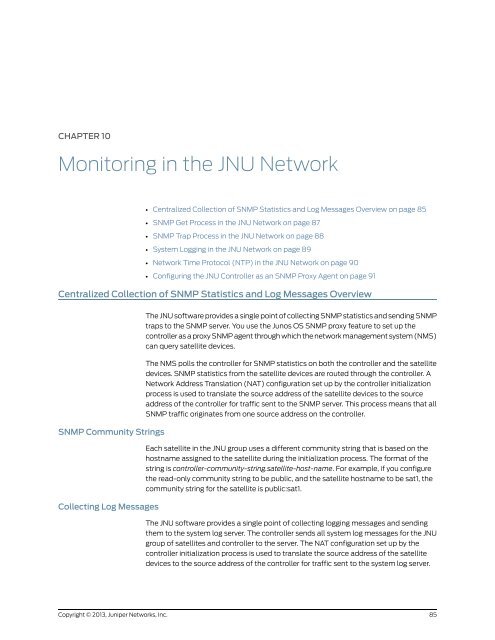Designing and Implementing a Junos Node Unifier Network
Designing and Implementing a Junos Node Unifier Network
Designing and Implementing a Junos Node Unifier Network
You also want an ePaper? Increase the reach of your titles
YUMPU automatically turns print PDFs into web optimized ePapers that Google loves.
CHAPTER 10<br />
Monitoring in the JNU <strong>Network</strong><br />
• Centralized Collection of SNMP Statistics <strong>and</strong> Log Messages Overview on page 85<br />
• SNMP Get Process in the JNU <strong>Network</strong> on page 87<br />
• SNMP Trap Process in the JNU <strong>Network</strong> on page 88<br />
• System Logging in the JNU <strong>Network</strong> on page 89<br />
• <strong>Network</strong> Time Protocol (NTP) in the JNU <strong>Network</strong> on page 90<br />
• Configuring the JNU Controller as an SNMP Proxy Agent on page 91<br />
Centralized Collection of SNMP Statistics <strong>and</strong> Log Messages Overview<br />
SNMP Community Strings<br />
Collecting Log Messages<br />
Copyright © 2013, Juniper <strong>Network</strong>s, Inc.<br />
The JNU software provides a single point of collecting SNMP statistics <strong>and</strong> sending SNMP<br />
traps to the SNMP server. You use the <strong>Junos</strong> OS SNMP proxy feature to set up the<br />
controller as a proxy SNMP agent through which the network management system (NMS)<br />
can query satellite devices.<br />
The NMS polls the controller for SNMP statistics on both the controller <strong>and</strong> the satellite<br />
devices. SNMP statistics from the satellite devices are routed through the controller. A<br />
<strong>Network</strong> Address Translation (NAT) configuration set up by the controller initialization<br />
process is used to translate the source address of the satellite devices to the source<br />
address of the controller for traffic sent to the SNMP server. This process means that all<br />
SNMP traffic originates from one source address on the controller.<br />
Each satellite in the JNU group uses a different community string that is based on the<br />
hostname assigned to the satellite during the initialization process. The format of the<br />
string is controller-community-string.satellite-host-name. For example, if you configure<br />
the read-only community string to be public, <strong>and</strong> the satellite hostname to be sat1, the<br />
community string for the satellite is public:sat1.<br />
The JNU software provides a single point of collecting logging messages <strong>and</strong> sending<br />
them to the system log server. The controller sends all system log messages for the JNU<br />
group of satellites <strong>and</strong> controller to the server. The NAT configuration set up by the<br />
controller initialization process is used to translate the source address of the satellite<br />
devices to the source address of the controller for traffic sent to the system log server.<br />
85
















